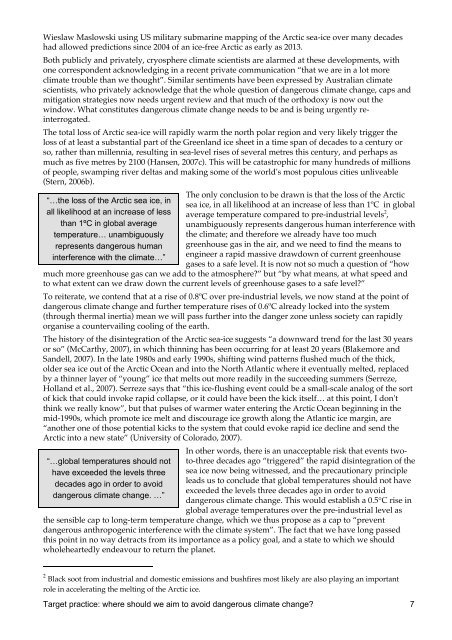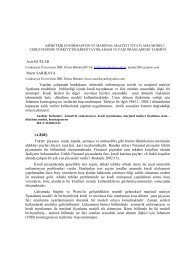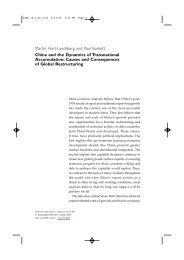where should we aim to prevent dangerous climate change?
where should we aim to prevent dangerous climate change?
where should we aim to prevent dangerous climate change?
Create successful ePaper yourself
Turn your PDF publications into a flip-book with our unique Google optimized e-Paper software.
Wieslaw Maslowski using US military submarine mapping of the Arctic sea-ice over many decadeshad allo<strong>we</strong>d predictions since 2004 of an ice-free Arctic as early as 2013.Both publicly and privately, cryosphere <strong>climate</strong> scientists are alarmed at these developments, withone correspondent acknowledging in a recent private communication “that <strong>we</strong> are in a lot more<strong>climate</strong> trouble than <strong>we</strong> thought”. Similar sentiments have been expressed by Australian <strong>climate</strong>scientists, who privately acknowledge that the whole question of <strong>dangerous</strong> <strong>climate</strong> <strong>change</strong>, caps andmitigation strategies now needs urgent review and that much of the orthodoxy is now out thewindow. What constitutes <strong>dangerous</strong> <strong>climate</strong> <strong>change</strong> needs <strong>to</strong> be and is being urgently reinterrogated.The <strong>to</strong>tal loss of Arctic sea-ice will rapidly warm the north polar region and very likely trigger theloss of at least a substantial part of the Greenland ice sheet in a time span of decades <strong>to</strong> a century orso, rather than millennia, resulting in sea-level rises of several metres this century, and perhaps asmuch as five metres by 2100 (Hansen, 2007c). This will be catastrophic for many hundreds of millionsof people, swamping river deltas and making some of the world's most populous cities unliveable(Stern, 2006b).“…the loss of the Arctic sea ice, inall likelihood at an increase of lessthan 1ºC in global averagetemperature… unambiguouslyrepresents <strong>dangerous</strong> humaninterference with the <strong>climate</strong>…”The only conclusion <strong>to</strong> be drawn is that the loss of the Arcticsea ice, in all likelihood at an increase of less than 1ºC in globalaverage temperature compared <strong>to</strong> pre-industrial levels 2 ,unambiguously represents <strong>dangerous</strong> human interference withthe <strong>climate</strong>; and therefore <strong>we</strong> already have <strong>to</strong>o muchgreenhouse gas in the air, and <strong>we</strong> need <strong>to</strong> find the means <strong>to</strong>engineer a rapid massive drawdown of current greenhousegases <strong>to</strong> a safe level. It is now not so much a question of “howmuch more greenhouse gas can <strong>we</strong> add <strong>to</strong> the atmosphere?” but “by what means, at what speed and<strong>to</strong> what extent can <strong>we</strong> draw down the current levels of greenhouse gases <strong>to</strong> a safe level?”To reiterate, <strong>we</strong> contend that at a rise of 0.8ºC over pre-industrial levels, <strong>we</strong> now stand at the point of<strong>dangerous</strong> <strong>climate</strong> <strong>change</strong> and further temperature rises of 0.6ºC already locked in<strong>to</strong> the system(through thermal inertia) mean <strong>we</strong> will pass further in<strong>to</strong> the danger zone unless society can rapidlyorganise a countervailing cooling of the earth.The his<strong>to</strong>ry of the disintegration of the Arctic sea-ice suggests “a downward trend for the last 30 yearsor so” (McCarthy, 2007), in which thinning has been occurring for at least 20 years (Blakemore andSandell, 2007). In the late 1980s and early 1990s, shifting wind patterns flushed much of the thick,older sea ice out of the Arctic Ocean and in<strong>to</strong> the North Atlantic <strong>where</strong> it eventually melted, replacedby a thinner layer of “young” ice that melts out more readily in the succeeding summers (Serreze,Holland et al., 2007). Serreze says that “this ice-flushing event could be a small-scale analog of the sor<strong>to</strong>f kick that could invoke rapid collapse, or it could have been the kick itself… at this point, I don'tthink <strong>we</strong> really know”, but that pulses of warmer water entering the Arctic Ocean beginning in themid-1990s, which promote ice melt and discourage ice growth along the Atlantic ice margin, are“another one of those potential kicks <strong>to</strong> the system that could evoke rapid ice decline and send theArctic in<strong>to</strong> a new state” (University of Colorado, 2007).“…global temperatures <strong>should</strong> nothave exceeded the levels threedecades ago in order <strong>to</strong> avoid<strong>dangerous</strong> <strong>climate</strong> <strong>change</strong>. …”In other words, there is an unacceptable risk that events two<strong>to</strong>-threedecades ago “triggered” the rapid disintegration of thesea ice now being witnessed, and the precautionary principleleads us <strong>to</strong> conclude that global temperatures <strong>should</strong> not haveexceeded the levels three decades ago in order <strong>to</strong> avoid<strong>dangerous</strong> <strong>climate</strong> <strong>change</strong>. This would establish a 0.5°C rise inglobal average temperatures over the pre-industrial level asthe sensible cap <strong>to</strong> long-term temperature <strong>change</strong>, which <strong>we</strong> thus propose as a cap <strong>to</strong> “<strong>prevent</strong><strong>dangerous</strong> anthropogenic interference with the <strong>climate</strong> system”. The fact that <strong>we</strong> have long passedthis point in no way detracts from its importance as a policy goal, and a state <strong>to</strong> which <strong>we</strong> <strong>should</strong>wholeheartedly endeavour <strong>to</strong> return the planet.2 Black soot from industrial and domestic emissions and bushfires most likely are also playing an importantrole in accelerating the melting of the Arctic ice.Target practice: <strong>where</strong> <strong>should</strong> <strong>we</strong> <strong>aim</strong> <strong>to</strong> avoid <strong>dangerous</strong> <strong>climate</strong> <strong>change</strong>? 7





